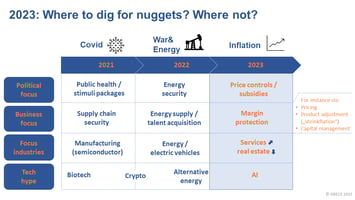Many angel investors got burned by investments in the heydays of cheap money. Now they are sitting...
Question to the wannabe entrepreneur: build a fintech or a SaaS business?
We are living in a rapidly evolving digital landscape where the business fads are changing constantly. Some years ago, all the buzz in the start-up world was around fintechs.
They challenged an industry, banking and financial services, characterized by manual processes in banking branches, bad customer-experience, and legacy tech systems. Now the “start-up crowd” has moved on to Software-as-a Service (SaaS).
Entrepreneurs build software solutions to replace or complement legacy systems that are operated on premises with UX designed decades ago.
Having spent more than five years working in multiple start-ups, with fintech being my main area of expertise, I have gathered a wealth of experience in these spaces. Recently, I transitioned to a SaaS scale-up in the accounting space, and my exposure to both business models has highlighted several commonalities, as well as stark differences.
What is fintech?
Fintech, an abbreviation for Finance and Technology, refers to businesses that leverage innovative technologies to offer financial services. These businesses seek to disrupt traditional financial institutions by providing faster, more efficient, and often more affordable products to consumers and businesses alike. Examples of fintech offerings include digital payment systems, lending platforms, cryptocurrency exchanges, and robo-advisors. The core objective is to make financial services more streamlined and customer-friendly.
A crucial characteristic of Fintech companies is that they operate in a highly regulated environment. Financial regulations vary from country to country, making compliance a complex and costly process. However, this can also serve as a protective barrier for established fintechs, as it makes it more difficult for new entrants to start a banking business.
What is SaaS?
SaaS (Software-as-a-Service) companies, on the other hand, provide cloud-based software applications. Rather than selling software licenses for installation on individual devices, SaaS companies offer access to their applications over the internet, usually on a subscription basis. This model allows for consistent, recurring revenue streams and enables businesses to scale quickly by serving a global customer base without needing to install physical infrastructure.
Common examples of SaaS companies include platforms like Salesforce, Slack, and HubSpot. These businesses often target other companies (B2B) and provide tools for critical business processes, such as managing customer relationships (CRM), marketing automation, or collaboration. The SaaS model thrives on product innovation and user experience, making it highly scalable if the product resonates with the target audience.
What do they have in common?
The most significant commonality between fintech and SaaS companies is their aim to generate recurring revenues from a customer base. Both business models typically operate on a subscription basis, meaning customers make regular payments, whether monthly, quarterly, or annually, to use the services. For Fintechs, this might take the form of recurring charges on accounts, cards, or credits. For SaaS companies, customers pay for continued access to the software platform.
This recurring revenue model helps businesses to make longer-term projections about cash flow. Thus, it justifies higher customer acquisition costs, as the customer will continue to generate income over a prolonged period as long as churn rates (i.e., the rate at which customers stop using the service) are kept under control.
Both models can also benefit from economies of scale. As these businesses grow, they can spread the cost of developing their platform, technology, and infrastructure over a larger customer base, which improves margins and profitability over time.
Key differences
While there are strong similarities, the differences between Fintech and SaaS are also substantial, leading to different capital requirements, ease to scale and long-time profitability.
Regulatory Complexity
Fintechs operate in a highly regulated industry: finance. Banking and financial institutions are tightly controlled by regulatory bodies to ensure the stability of financial systems and data privacy. For a Fintech startup, this means navigating a complex maze of special laws and compliance requirements even before servicing the first customer.
However, these regulations, while cumbersome, can also act as a moat. Once a Fintech startup successfully establishes itself, it becomes much harder for new competitors to enter the space and replicate the business model without significant regulatory investments.
SaaS companies, by contrast, typically face fewer regulatory hurdles and this makes it easier and faster to bring a SaaS product to market.
Capital requirements
The capital required to start and operate a Fintech business is much higher than for SaaS companies. In addition to the costs of developing a product and acquiring customers, Fintechs must also set aside regulatory capital. Regulatory bodies require financial institutions to maintain a certain amount of capital to ensure solvency and protect against losses.
In contrast, SaaS businesses generally have lower capital requirements. Once the product is developed and the platform is built, the ongoing costs tend to be lower, especially if the company adopts a product-led growth strategy. This difference in capital requirements makes SaaS companies more attractive to entrepreneurs who want to bootstrap their business without requiring large sums of initial funding.
Sales vs. product-led growth
Another significant difference between fintech and SaaS lies in their approach to growth. Fintech companies often need to rely heavily on marketing and sales to attract customers. Banking products, in general, do not generate a buzz with customers as they are not loaded emotionally. This makes it harder for Fintechs to leverage product-led growth, where the product itself is the primary driver of customer acquisition. Instead, most Fintechs must invest heavily in marketing dollars to build brand awareness and trust.
SaaS companies, however, can excel in product-led growth. An innovative SaaS product can go viral, spreading through word of mouth or viral marketing campaigns. In some cases, a free or freemium version of the product can attract a large user base, which can then be converted into paying customers.
Margins and competition
SaaS businesses generally enjoy higher gross margins, often exceeding 70% of revenues. These high margins make SaaS attractive to investors and entrepreneurs alike. However, these margins can quickly erode in a competitive market, especially if competitors are able to offer a similar product at a lower price or with better features.
Fintechs, on the other hand, operate with much thinner margins, often measured in basis points (1/100th of a percent).
While these margins seem razor thin, they tend to be more stable over time, and Fintechs are less vulnerable to pricing pressure than SaaS companies. On top, customers do not tend to switch providers easily.
Conclusion
Both Fintech and SaaS offer exciting opportunities for entrepreneurs, but the risk/reward profile looks quite different. Fintechs require navigating a complex legal and regulatory landscape which, if done well, can result in a competitive advantage.
On top, operating a Fintech requires more capital, but therefore they benefit from greater stability and protection from competition. SaaS businesses, meanwhile, are more agile, require less capital, and can scale quickly, but they face more competition and the potential for rapid margin erosion.


